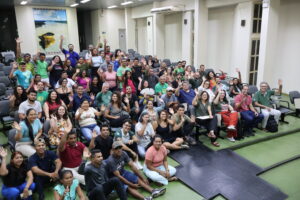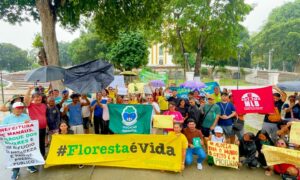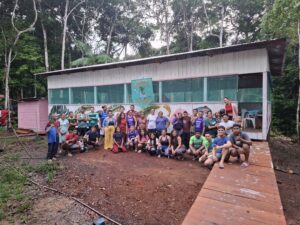The protest gathered people in Brasilia, on March 9, to demand the end of the “Destruction Package”, a set of environmental-related bills.
By Letícia Araújo
Instituto Juruá was one of the 238 organizations signatories of the open letter produced by the organizers of the Ato pela Terra (Act for the Earth), which took place on March 9, in Brasilia. The Act was conceived by Caetano Veloso together with 342 Amazônia, and also had the support of other artists and organizations, such as Maria Gadú, Daniela Mercury, WWF-Brasil, Fase, MTST, Baco Exu do Blues, Letícia Sabatella, Seu Jorge and Lázaro Ramos.
The main target of the protests was the “Destruction Package”, a set of bills related to the environment. There were six main projects: the “Poison Package” (Bill No. 6.2999/02), which makes the use of pesticides more flexible; projects dealing with land regularization (Bill No. 2.633/20 and Bill No. 510/21), which pave the way for land grabbing; projects that directly affect indigenous lands (Bill No. 490/07 and Bill No. 191/20), facilitating the exploitation of these territories; and the environmental licensing bill (Bill No. 2.159/21), which facilitates access to this pass.
Nathália Messina, the strategic articulator of Instituto Juruá, was responsible for signing the letter on behalf of the institute. In her opinion, positioning herself against the “Destruction Package” was necessary, since the bills “directly focus on environmentally and socially protected territories and that at some point, if approved, they can reach several Brazilian and Amazon territories, including the middle course of the Juruá basin.”
In addition to the support of social organizations, the demonstration also had the cooperation of several artists, especially Caetano Veloso, who headed the movement. The Act manifest was delivered to the Ministers of the Supreme Court Rosa Weber, Carmen Lúcia, Luís Barros, and Alexandre de Moraes by some artists and protesters before the beginning of the cultural activities.

Rud Rafael, from the national coordination of the Homeless Workers’ Movement, was one of those responsible for organizing the Act. For the activist, one of the highlights was the presence of different movements and social organizations, along with great Brazilian artists: “an extremely important engagement that caused the act to reach more audiences, gathering a lot of spontaneous youngsters, an audience that we do not see in every act normally”.
For the activist, who was present at the manifestation in Brasilia, the Act was “gigantic from the point of view of mobilization, and I think it brought an enchantment, a great feeling of hope […] I think the Act managed to put the theme on the political agenda of Brazilian society, a theme that for a long time was made invisible”.
Despite the significant manifestation, there is still much work to be done. Even before the closure of the Act, the House of Representatives approved the urgency regime for Bill 191, which deals with the predatory exploitation of indigenous lands for mining – one of the main demands of the Indigenous April, which, in 2022, will take place with the 18th edition of the Acampamento Terra Livre (“Free Land Camp”).
Instituto Juruá reaffirms its support for the movement, as Messina explains: “This is why we join movements like this one of such sociopolitical, artistic and cultural expression, gathering voices to, together, produce a healthy future for human life on Earth.”






